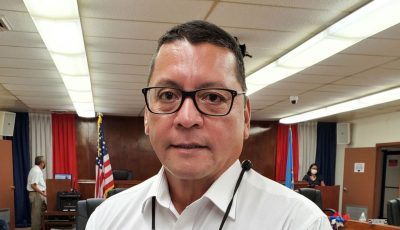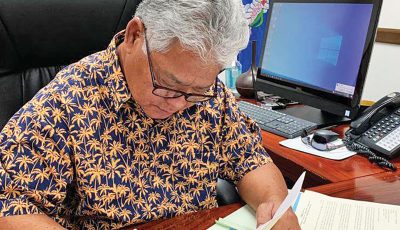Sablan: A vote for HLI 18-12 is an investment in education

House Legislative Initiative 18-12 posters fill the Public School System’s entrance. (Thomas Manglona II)
According to Education Commissioner Dr. Rita A. Sablan, the legislative initiative is a “historic” one.
“It had to originate somewhere,” she said. “And it originated out of a lot of conversations we had at our Legislature meetings about our budget in the Public School System. Each time we went there, we asked for a budget that would be sufficient to operate the school district.”
Sablan noted that since assuming the position of commissioner in 2008, the school system has not received its desired $40 million.
“The Constitution says we get a minimum of 15 percent, but each time we go up there we fight for more than 15 percent,” she added. “In the past years we have been given 22 to 24 percent of the budget. And the 25 percent is a conversation that has happened over the last couple of years.”
After a unanimous vote to put the question on the ballot by the House and Senate, Sablan now urges people to do their part and exercise their right to vote for “the investment in education
Sablan said the initiative is not just about current students but future students as well.
“We need the funding now to support the programs that are key to every student.”
The Public School System has conducted major advertising highlighting what the additional funds will be used for if HLI 18-12 were to receive a majority “Yes” vote tomorrow.
Full-day kindergarten programs, continuous school improvement, and modernization of school facilities, class size reduction, and classroom instructional materials and technology are things that the Public School System will be able to afford if HLI 18-12 passes.
“If we all continue to work together for the children, then this initiative should pass,” she said.
The initiative has also raised questions of the financial accountability of PSS, with the possibility of receiving 25 percent annually.
Sablan told Saipan Tribune that PSS’ accountability is already established in the community.
“I think we are the only agency that puts out a monthly newsletter. We go on the radio and television to show the public the performance that we do against the dollars that we get,” she explained. “We make it public where we are with finances and using our money and showing where we are cutting and where we need to put more money into. All of our reports are also on our website.”
Sablan said the Parent, Teacher, and Student Association will play a key role in developing priorities with more funding.
“A plan will also be developed involving all key stakeholders that are concerned with where the dollars are going,” she said.
Sablan pointed out that public education is very costly. “Everything is free and nothing is provided for.”
She said that she cannot unequivocally say that the funds will ever be enough because of a “very diverse demographic and needs” of parents and students.
She noted that the needs of every campus are different and each year the funds requested are based solely on the needs of that school year.
The funds currently received by PSS allow the system to scrape by, while the student population grows, along with the classroom sizes.
“The commitment we get from the staff and teachers is what really keeps us afloat,” she said. “I have principals working until 10pm. I have teachers who leave work after 4:30. They go to PTSA meetings, soccer games, and a lot of other events for the students. The staffs’ cohesiveness allows us to make things happen every year.”
Sablan has personally talked to voters and listened to their concerns.
“There have been a lot of good vibes. People are curious and enthusiastic about it. A couple of people are still questioning the initiative and are welcome to talk to us to understand what this is about,” she said.


























